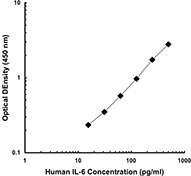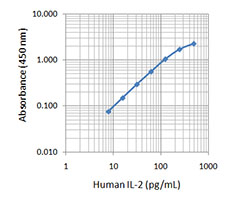- Clone
- 112-1 (See other available formats)
- Regulatory Status
- RUO
- Other Names
- GBP-28, apM1, AdipoQ, and Acrp30
- Isotype
- Mouse IgG1, κ
- Ave. Rating
- Submit a Review
- Product Citations
- publications
| Cat # | Size | Price | Quantity Check Availability | Save | ||
|---|---|---|---|---|---|---|
| 528803 | 50 µg | 176 CHF | ||||
| 528804 | 500 µg | 581 CHF | ||||
Adiponectin, also referred as Acrp30, AdipoQ, apM1, and gelatin binding protein of 28 kD (GBP-28), is encoded by the ADIPOQ gene in humans. Adiponectin contains 244 amino acids with a collagen-like domain at the N-terminal and a globular domain at the C-terminal. The globular domain can be proteolytically truncated forming the globular adiponectin (gAdiponectin). This globular domain resembles the structure of the complement C1q and the TNF-α superfamily. Adiponectin exists in a wide range of homo-oligomers: a low-molecular weight (LMW) trimer, a medium molecular weight (MMW) hexamer, and a high molecular weight (HMW) multimer with little or no interconversion between the forms. Females generally have higher HMW than males in proportion and absolute amounts. Adiponectin has two receptors (adipoRs)-1 and -2. AdipoR1 mRNA is detectable in skeletal muscle, spleen, lung, heart, kidney, and liver. AdipoR2 is expressed in liver, but is also detectable in heart, lung, skeletal muscle, and kidney.
Adiponectin plays an important role in carbohydrate and lipid metabolism. It promotes insulin-sensitivity and protects cells from inflammation and apoptosis. It is also hypothesized to have anti-atherogenic activity. Normal circulating adiponectin level ranges from 4-30 µg/mL. Adiponectin levels are inversely correlated with body mass index (BMI). Low serum level of adiponectin is found in obesity, type 2 diabetes and those with coronary artery disease. Therefore, adiponectin serves as an important clinical biomarker for metabolic syndromes.
Product Details
- Verified Reactivity
- Human
- Antibody Type
- Monoclonal
- Host Species
- Mouse
- Immunogen
- Recombinant human Adiponectin
- Formulation
- Phosphate-buffered solution, pH 7.2, containing 0.09% sodium azide.
- Preparation
- The antibody was purified by affinity chromatography and conjugated with biotin under optimal conditions.
- Concentration
- 0.5 mg/ml
- Storage & Handling
- The antibody solution should be stored undiluted between 2°C and 8°C. Do not freeze.
- Application
-
ELISA Detection - Quality tested
- Recommended Usage
-
Each lot of this antibody is quality control tested by ELISA assay. For ELISA capture applications, a concentration range of 0.05-0.2 µg/ml is recommended. To obtain a linear standard curve, serial dilutions of Adiponectin protein ranging from 10,000 to 156 pg/ml are recommended for each ELISA plate. It is recommended that the reagent be titrated for optimal performance for each application.
- Application Notes
-
ELISA Detection: The biotinylated 112-1 antibody is useful as the detection antibody in a sandwich ELISA assay, when used in conjunction with the purified 62-9 antibody as the capture antibody and human Adiponectin protein as the standard.
For testing human Adiponectin (Acrp30) in serum, plasma, or supernatant, BioLegend’s ELISA LEGEND MAX™ Kits are specially developed and recommended. - RRID
-
AB_2571888 (BioLegend Cat. No. 528803)
AB_2571888 (BioLegend Cat. No. 528804)
Antigen Details
- Structure
- Protein hormone.
- Distribution
- Adipose tissue.
- Function
- Modulates a number of metabolic processes including glucose regulation and fatty acid oxidation.
- Interaction
- Liver, heart, lung, skeletal muscle, and kidney.
- Ligand/Receptor
- Adiponectin receptor 2
- Biology Area
- Complement
- Antigen References
-
1. Ouchi N, et al. 2000. Circulation 102:1296.
2. Ouchi N, et al. 1999. Circulation 100:2473-6.
3. Nakano Y, et al. 1996. J. Biochem. 120:803.
4. Yokota T, et al. 2000. Blood 96:1723. - Gene ID
- 9370 View all products for this Gene ID
- UniProt
- View information about Adiponectin on UniProt.org
Related Pages & Pathways
Pages
Related FAQs
- How many biotin molecules are per antibody structure?
- We don't routinely measure the number of biotins with our antibody products but the number of biotin molecules range from 3-6 molecules per antibody.
Other Formats
View All Adiponectin (Acrp30) Reagents Request Custom Conjugation| Description | Clone | Applications |
|---|---|---|
| Biotin anti-human Adiponectin (Acrp30) | 112-1 | ELISA Detection |
Customers Also Purchased


Compare Data Across All Formats
This data display is provided for general comparisons between formats.
Your actual data may vary due to variations in samples, target cells, instruments and their settings, staining conditions, and other factors.
If you need assistance with selecting the best format contact our expert technical support team.
-
Biotin anti-human Adiponectin (Acrp30)
 Login / Register
Login / Register 












Follow Us